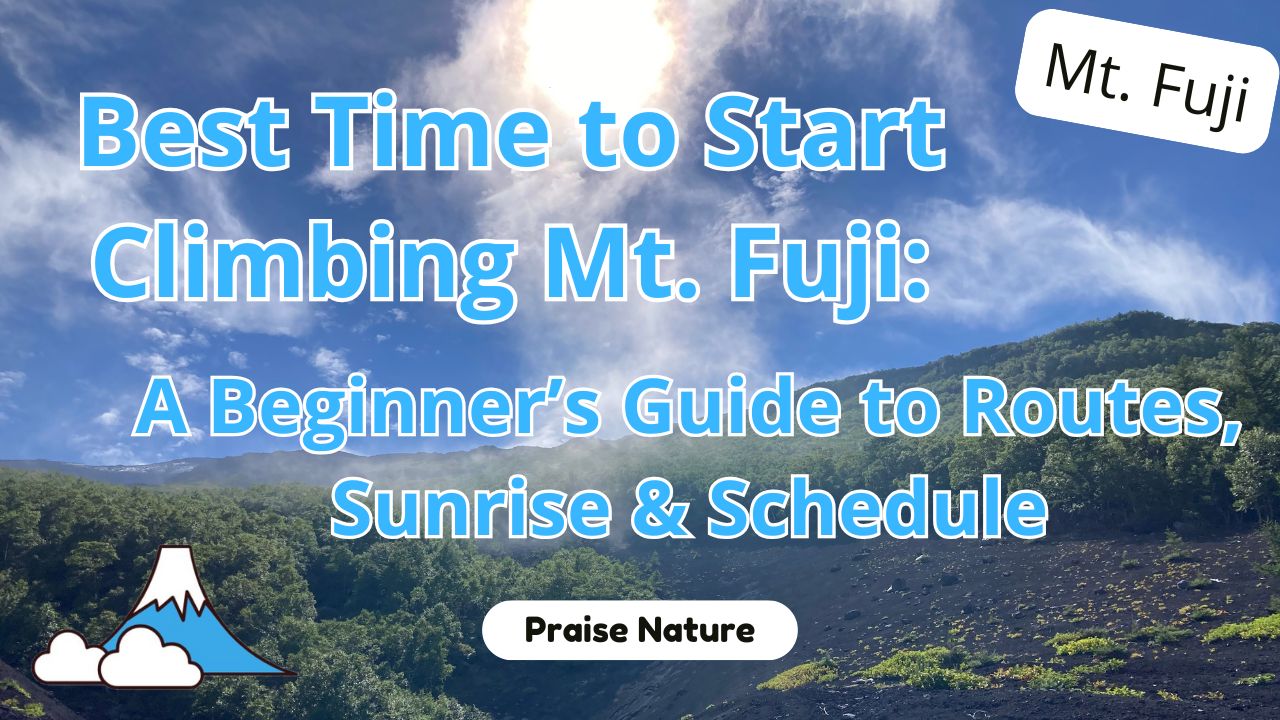If you're planning your first climb up Mt. Fuji, you might be wondering: what's the best time to start? And when are you actually allowed to begin your ascent?
This article will walk you through the ideal start time for a first-time Mt. Fuji climb. By the end, you’ll have a clear sense of the climb's general timeline and a solid reason for picking your start time.
What Are the Mt. Fuji Climbing Routes?
There are four main trails to Mt. Fuji:
Yoshida Trail (Yamanashi Prefecture): On the north side of Mt. Fuji, it has the most mountain huts (around 20) and is the most popular trail for first-time climbers. The 5th Station is lively with shops and restaurants. Ascent and descent paths are separated, so there are fewer traffic jams.
Subashiri Trail (Shizuoka Prefecture): Located on the east side, this trail offers lush forest up to high altitudes. It also sees a fair number of climbers. A highlight is the "Sunabashiri," where you can run down a sandy slope on descent.
Gotemba Trail (Shizuoka Prefecture): On the south side, this trail starts at the lowest elevation. While the incline is gentler, the distance is much longer. With fewer huts and climbers, it's quieter but more suited for experienced hikers.
Fujinomiya Trail (Shizuoka Prefecture): This trail starts at the highest elevation, making it the shortest route to the summit, but it's steeper and rockier. It has about 8 huts and is the second most popular route. There's also a "Prince Route," which descends via Gotemba Trail and connects back through Mt. Hoei.
Besides these four, the Prince Route connects the Fujinomiya and Gotemba trails via Mt. Hoei.
What Time Can You Start Climbing?
During the official climbing season, private cars are generally restricted from accessing the 5th Stations of each trail due to vehicle regulations. However, at the beginning and end of the season (a few days in July and September), private cars may be allowed.
| Climbing Routes | Road Names | Open Hours | Private Vehicle Restrictions |
|---|---|---|---|
| Yoshida Trail | Fuji Subaru Line | AM3:00~PM6:00 | In effect |
| Subashiri Trail | Fujiazami Line | Open 24 hours | In effect |
| Gotemba Trail | Mt. Fuji Skyline → Fuji Park Tarōbō Line | Open 24 hours | Not in effect |
| Fujinomiya Trail | Mt. Fuji Skyline | Open 24 hours | In effect |
For the Yoshida Trail, access via the Fuji Subaru Line is restricted until 3:00 AM, even outside regulated periods. This means the earliest you can start climbing is around 4:00 AM.
Other trails (Subashiri, Gotemba, Fujinomiya) are accessible 24 hours a day, allowing for more flexible start times.
During the regulated season, you'll need to park your car at the base and take a shuttle bus to the 5th Station. Shuttle bus schedules also affect when you can start climbing.
Stricter Entry Limits on Mt. Fuji
Due to increased climber numbers, the Yoshida Trail sometimes imposes entry limits. If more than 4,000 people pass through in a day, entry may be restricted.
However, climbers with a mountain hut reservation are typically allowed entry. You must show proof, like an email or a screenshot of your booking.
Because of this, starting your climb earlier in the day is recommended to avoid restrictions.
Recommended Start Time for Climbing
Here’s our recommended starting time for the Yoshida Trail — the most popular route for climbing Mt. Fuji.
This guide assumes a two-day, one-night itinerary using a mountain hut, which is the recommended way to climb Mt. Fuji — rather than attempting a one-day round trip.
Even from the 5th Station, the standard time for the climb is around 10 hours and 15 minutes in total: about 6 hours and 10 minutes going up, and 4 hours and 5 minutes coming down.
That’s why, if this is your first time climbing Mt. Fuji — or if you’re a beginner — we strongly recommend taking it slow with an overnight stay at a mountain hut instead of doing a one-day climb.
Day 1: Start from the 5th Station
A typical itinerary for the Yoshida Trail begins at the 5th Station (Yoshida Trailhead), with an overnight stay at a mountain hut around the 7th or 8th Station, followed by the final ascent to the summit the next day.
Depending on the location (and elevation) of your chosen mountain hut, the hike from the 5th Station to the 7th or 8th Station usually takes about 3 to 4 hours. From there, it's another 3 to 4 hours to reach the summit.
For this reason, many climbers begin their ascent from the 5th Station between 12:00 PM and 2:00 PM. Leaving around this time allows you to reach the mountain hut between 3:00 PM and 6:00 PM.
It’s also recommended to spend about two hours at the 5th Station before starting your climb. This helps your body adjust to the higher altitude.
So, working backward, it’s ideal to arrive at the 5th Station (Yoshida Trailhead) between 10:00 AM and 12:00 PM.
Day 2: From the Hut to the Summit
On the second day, the best time to start your climb depends on several factors — such as where you want to see the sunrise (Goraikō), your return bus or train schedule, crowd levels on the trail, and your own physical condition.
Sunrise near the summit of Mt. Fuji is around 5:00 AM. So, if you want to watch the sunrise from the summit, you’ll need to leave your mountain hut between 1:00 AM and 2:00 AM.
However, during busy times like weekends or the Obon holiday period, the trail near the summit can become very crowded, leading to traffic jams. In those cases, you may need to start even earlier.
Although the standard time to climb from the 7th or 8th Station huts to the summit is about 3 to 4 hours, it can take longer depending on your fitness level and age.
A view of the trail near the 9th Station of Mt. Fuji. From September onward, it’s not uncommon to see snowfall near the summit.
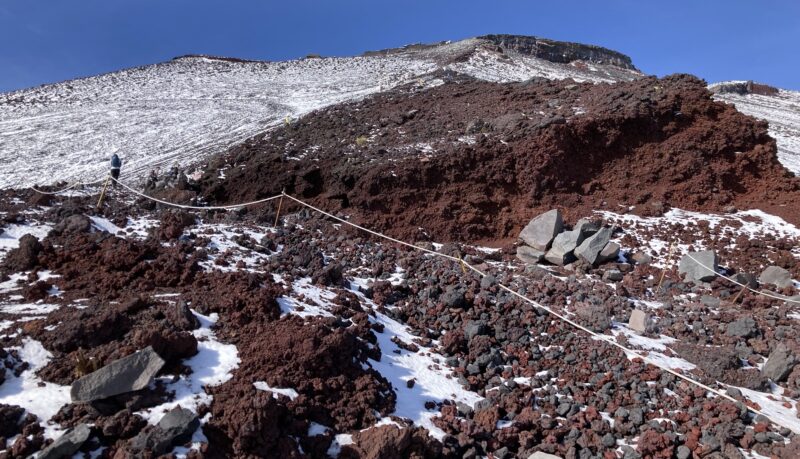
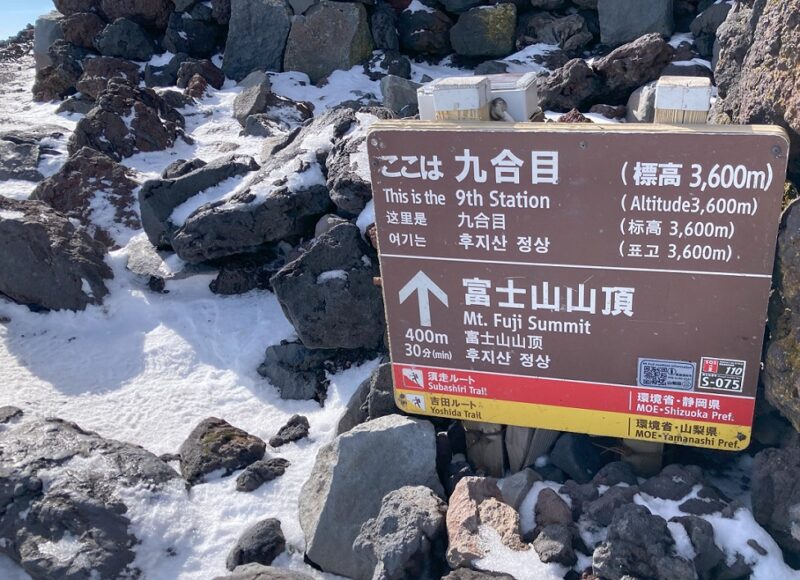
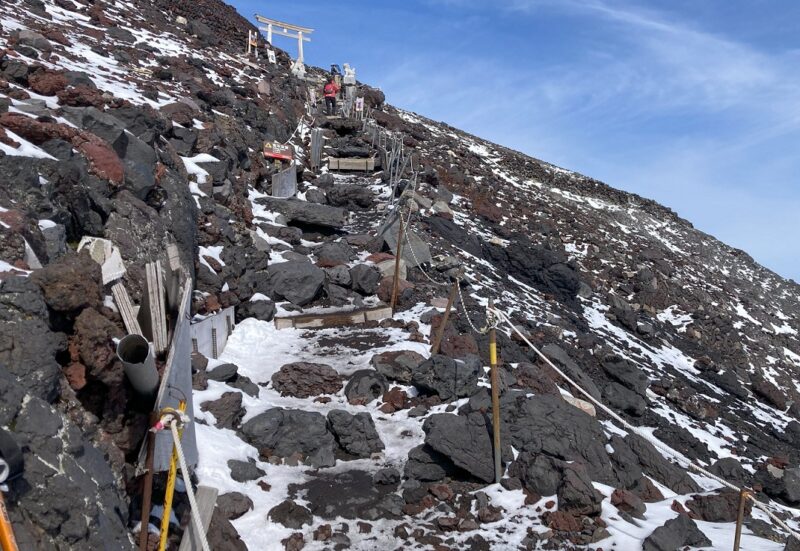
From the 8th Station onward, the altitude exceeds 3,000 meters, and depending on your physical condition and age, it can take up to twice the standard climbing time.
For example, in my case, when I climbed Mt. Fuji for the first time at age 40, it took me one full hour to get from the 9th Station to the summit, even though the standard time is just 30 minutes.
Near the summit, the air becomes noticeably thinner, and I quickly found myself short of breath, huffing and puffing, with my walking pace slowing down drastically.
I noticed I was passing some older climbers along the way, so for those who are even older, it's likely to take even longer.
On the other hand, younger climbers in their 20s and people with more hiking experience didn’t seem as out of breath, and many passed me along the way. It felt like the younger and more athletic climbers were able to stick to the standard times.
Because of this, if you're young or physically fit — especially if you regularly do endurance-based exercise — you’ll likely be fine with the standard timing from the mountain hut to the summit. But if you're older or not used to regular exercise, it's better to allow up to twice the standard time to reach the summit.
Personally, I think that if you're older or not confident in your fitness, it's perfectly okay not to insist on seeing the sunrise from the summit.
Since the Yoshida Trail climbs the eastern side of Mt. Fuji, you can still enjoy a beautiful sunrise (Goraikō) from the trail itself.
The view of the sunrise from the trail is stunning, and the extra rest time helps you recover and conserve your energy — which is a big advantage.
This is the sunrise (Goraikō) as seen from the 8th Station of Mt. Fuji, at an altitude of around 3,100 meters.
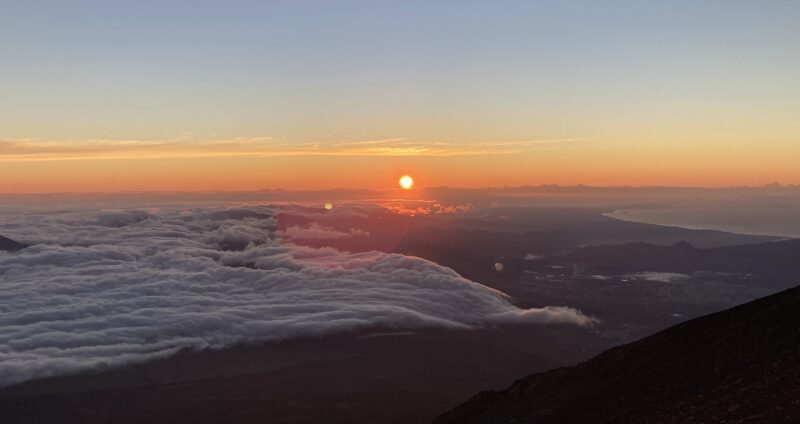
If you're okay with watching the sunrise (Goraikō) from the trail rather than the summit, you can start climbing a bit later.
If you begin your hike before sunrise, and the night sky is clear, you might also be treated to a breathtaking view of the stars.
For this type of plan, a recommended start time is between 3:00 and 4:00 AM.
Most mountain huts have a checkout time around sunrise — typically around 5:00 AM. So at the latest, you'll need to begin your hike between 5:00 and 6:00 AM.
Here’s a summary of how to decide your Day 2 start time:
- If you want to see the sunrise from the summit:
Start between 1:00 AM and 2:00 AM.
If you’re older or not confident in your stamina, consider starting even earlier.
During peak seasons like "Obon" or weekends, plan for an even earlier start due to trail congestion near the summit. - If you're happy to see the sunrise from the trail instead of the summit:
Starting by 3:00–4:00 AM is fine. - If you plan to watch the sunrise from the mountain hut and then start climbing:
Waking up by 5:00 AM should be enough.
Renting Climbing Gear for Mt. Fuji
If you want to rent the necessary climbing gear for Mt. Fuji cheaply and conveniently, we recommend "Yamarent -Gear Rental-
![]() ".
".
There are rental shops located right at the 5th Station on the Yoshida and Fujinomiya routes, so you can pick up your gear there before your climb and return it afterward at the same spot. What’s more, you can get a discount if you choose to pick up your gear at the 5th Station.
In my case, I didn’t own rainwear or a headlamp, so I decided to rent them.
I considered buying rainwear, but it was more expensive than I expected. So I chose to rent it to try out the performance of rain gear made by a well-known outdoor brand.
As for the headlamp, since I rarely hike at night like on Mt. Fuji, I thought renting one made more sense.
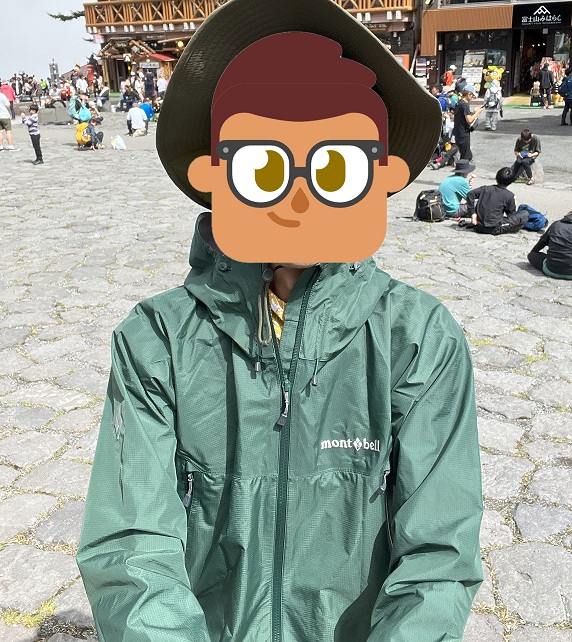
The rainwear I rented was the Rain Dancer by mont-bell.
It uses GORE-TEX and is fairly pricey if you buy it.
The fabric had a crinkly feel and repelled rain effectively.
I wore it once during a shower while hiking, and again at the summit to block the cold wind.
It was absolutely helpful and never caused any inconvenience.
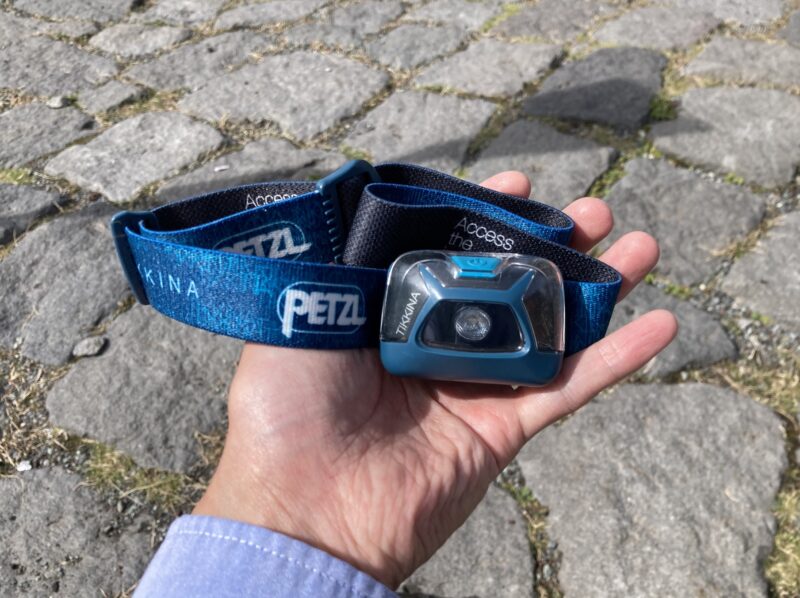
The headlamp I rented was made by PETZL. It was lightweight, bright enough, and very comfortable to use. The rental kit also included spare batteries in case the main ones ran out — a thoughtful touch that gave me peace of mind.
I rented from the shop at the 5th Station on the Yoshida Route. Both the pickup and return process were smooth. Renting directly at the 5th Station was simple, convenient, and cost-effective — highly recommended!
There is also a rental shop at the 5th Station on the Fujinomiya Route.
Of course, they offer a wide range of other climbing gear rentals beyond headlamps.
Renting gear is ideal for people like:
■Summary
Renting Climbing Gear for Mt. Fuji!
・Rent and return gear right at Mt. Fuji's 5th Station
・Everything you need for climbing, from hats to gloves
・Choose from a variety of sizes, gear grades, and colors

